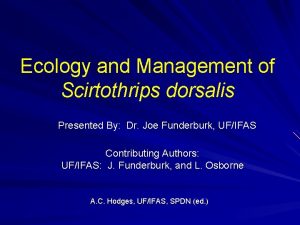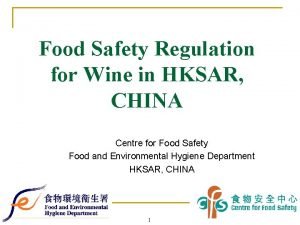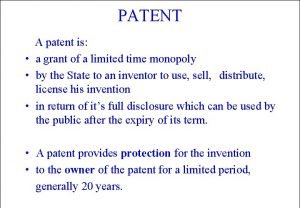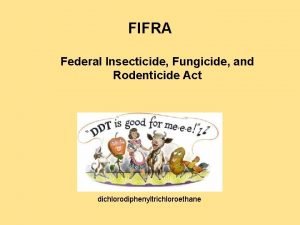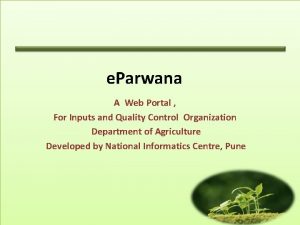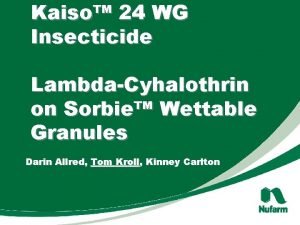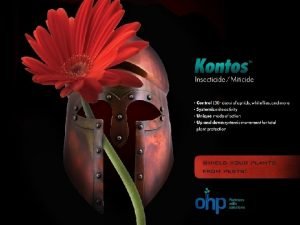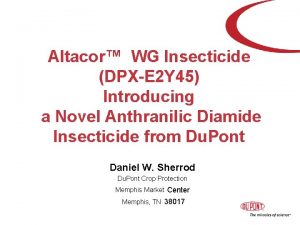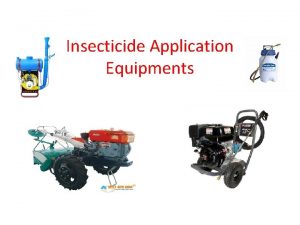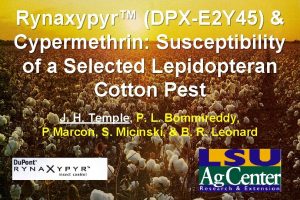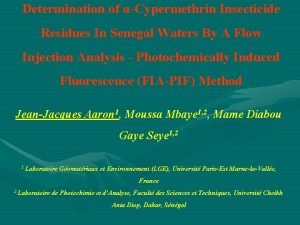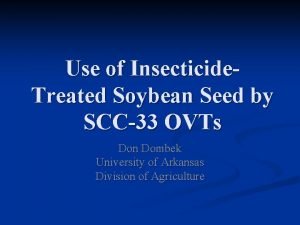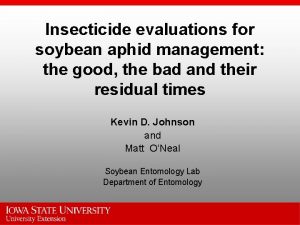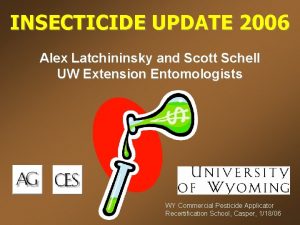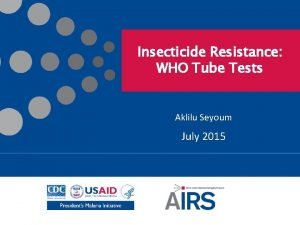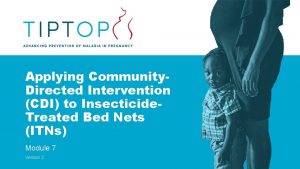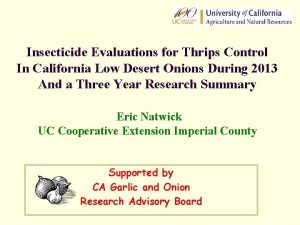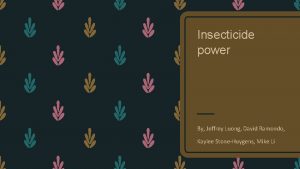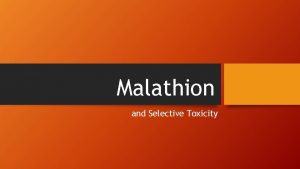Altacor WG Insecticide DPXE 2 Y 45 Introducing
























- Slides: 24

Altacor™ WG Insecticide (DPX-E 2 Y 45) Introducing a Novel Anthranilic Diamide Insecticide from Du. Pont Daniel W. Sherrod Du. Pont Crop Protection Memphis Market Center Memphis, TN 38017

Du. Pont Crop Protection q Code: DPX-E 2 Y 45 q Common Name: Chlorantraniliprole (ISO) - Rynaxypyr. TM q CAS: 3 -Bromo-N-[4 -chloro-2 -methyl-6[(methylamino)carbonyl]phenyl]-1(3 -chloro-2 -pyridinyl)-1 H-pyrazole-5 carboxamide Br q Chemical Structure: H H 3 C Cl N O H N N N O CH 3 q Empirical Formula: C 18 H 14 Br. Cl 2 N 5 O 2 q Molecular Weight: 483. 15 g/mole N Cl

Du. Pont Crop Protection Activates Insect Ryanodine Receptors Rynaxypyr™ EC 50 = 40 n. M q Rynaxypyr™ and related anthranilic diamides stimulate release of Ca 2+ stores q Rynaxypyr™ is selective for ryanodine receptors q Insecticidal activity is highly correlated with Ca 2+ store release

Du. Pont Crop Protection Does Not Impact Commercialized Targets Below Reflect Mo. A for > 90% of Commercial Insecticides Excitatory Neuron Muscle OPs Carbamates Na+/K+ channels Pyrethroids Indoxacarb s s e en il i od on l c pr y C Fi Glut GABA Motor Neuron M oid n i ot ad c i on inos e N Sp ACh. E Mi to Ins cho ec ndr tic ide ial s M Insect Neuromuscular Signaling Pathway

Du. Pont Crop Protection What is the Ryanodine Receptor (Ry. R)? Ryanodine Receptor Complex CAM FK BP CAM FK n BP tin Tr ia di nc q Calcium channel Ry. R Ju Ryanodine (Natural Plant Toxin) cytosol Ry. R lumen CS Q Ca 2+ q Regulates release of stored calcium q Critical for muscle contraction q Complex includes accessory proteins q Previously, no synthetic Ry. R agents known with insecticidal properties

Du. Pont Crop Protection Insect Poisoning Symptoms Rapidly Affects Skeletal and Cardiac Muscle q Rapid feeding cessation q General lethargy q Partial paralysis q Regurgitation

Du. Pont Crop Protection Resistance Management Baseline Susceptibility q Heliothines § Australia, Brazil, India, Spain, USA q Spodoptera spp. § Brazil, Indonesia, Japan, Malaysia, Spain, Thailand, USA, Vietnam

Du. Pont Crop Protection Effects of DPX-E 2 Y 45 in the Environment Bees • Negligible risk in field studies Non-target • Insects T 1: Negligible toxicity to standard species (mites, parasitoids) + Chrysoperla, Orius • T 2 to T 4: Safety to predatory larvae of Coccinellids and Episyrphus Birds and Mammals • Negligible risk Surface water Plants • Negligible risk • No/low transport to flowering parts Soil • Earthworms: Negligible risk • Soil Micro: Negligible risk • Fish: Negligible risk • Algae: Negligible risk • Aquatic Inverts: § High acute toxicity § Moderate chronic toxicity Sediment • Chironomus: Negligible to moderate risk

Du. Pont Crop Protection Mammalian Toxicity q E 2 Y 45 exhibits a remarkably favorable toxicity profile q Little or no toxicological effects have been observed following single doses as high as 5000 mg/kg bw and following repeat doses as high as ~1500 mg/kg bw/day q The low toxicity of this product combined with low use rates provide large margins of safety for consumers and workers

Du. Pont Crop Protection E 2 Y 45: Mammalian Toxicology q Lack of adverse effects for the following endpoints: § § § § § Acute oral, dermal and inhalation toxicity Skin and eye irritation; skin sensitization Genotoxicity in vitro and in vivo Subacute and subchronic toxicity in rats, mice, and dogs Reproductive and developmental toxicity Neurotoxicity Immunotoxicity Chronic toxicity after 1 year in dogs Chronic toxicity after 1 and 2 years in rats Oncogenicity after 2 years in rats and 18 months in mice

Du. Pont Crop Protection Rynaxypyr™ Exhibits Insect Receptor Selectivity Insect Receptor: Mammalian Receptor: 120 Single isoform Ry. R 1 – “skeletal” Cell Line PC 12 C 2 C 12 IMR 32 Source Rat Mouse Human Ry. R 2 – “cardiac” Ry. R 3 – “non-specific” Expressed Isoforms Ry. R 2 & Ry. R 1 & Ry. R 3 Not Defined Insect Normalized Response (% of max) Periplaneta 100 Drosophila Heliothis 80 Mammalian C 2 C 12 EC 50 = 14 m PC 12 60 EC 50 > 100 m IMR 32 EC 50 > 100 m 350 to >3000 X Selectivity 40 20 0 -9. 0 -8. 0 -7. 0 -6. 0 -5. 0 Rynaxypyr. TM Concentration (log M) -4. 0

Du. Pont Crop Protection Selectivity to Beneficial Arthropods ORDER Neuroptera Coleoptera FAMILY Chrysopidae Coccinellidae SPECIES Chrysoperla carnea Mallada signatus Hippodamia sp. Hippodamia variegatta RATE (g ai/Ha) 25 -100 30 -60 25 30 Harmonia axyridis 50 -100 Hemiptera Nabidae Nabis kimbergii 30 Anthrocoridae Orius insidiosus 50 Anthocoris nemoralis 60 Lygaeidae Geocoris punctipes 50 Acari Phytoseiidae Amblyseius herbicolus 100 Euseius citrifolius 100 Iphiseiodes zulugai 100 Typhlodromus occidentalis 50 -100 Hymenoptera Trichogrammatidae Trichogramma pretiosum 60 Trichogramma chilonis 33 Braconidae Bracon hebetor 50 Dolichogidea tasmanica 30 -60 Encyrtidae Ageniaspis citricola 50 Aphelinidae Aphelinus mali 30 -60 █ no impact, (0 -30% mortality); (Ratings according to IOBC/ WPRS Working Group, Hassan et al. 1988).

Du. Pont Crop Protection Pest Spectrum – Lepidoptera q Noctuidae § § Heliothines (bollworms, budworms), Earias spp. (bollworms) Spodoptera spp. (armyworms), Agrotis (cutworms) Pseudoplusia, Trichoplusia (loopers) Alabama argillaceae (leaf worms) q Tortricidae § Argytotaenia, Choristoneura (leafrollers) § Carposina, Cydia, Grapholita (fruit moths), Lobesia (berry moths) q Crambidae § § Chilo (stem borers), Ostrinia (corn borers) Hellula (cabbage worms) Lerodea (leaf folders) Leucinodes, Neoleucinodes (fruit borers) q Gelechiidae, Pieridae, Plutellidae § Anarsia (twig borers), Tuta, Keiferia (pin worms) § Pieris (whites, sulfur) § Plutella xylostella (diamondback moth) q Gracillariidae § Phyllonorycter, Phyllocnistis (leafminers)

Du. Pont Crop Protection Formulations q 20 SC § 200 g/L suspension concentrate § 1. 667 lb ai/gal suspension concentrate § Coragen. TM q 35 WG § 35% water dispersible granule § Altacor. TM q Formulation Studies § Excellent compatibility with other insecticides/fungicides § Excellent spray tank clean-out properties § Excellent mixing and handling characteristics

Du. Pont Crop Protection Product Attributes q Excellent plant protection on a broad spectrum of Lepidoptera and other key pest species, effective at low rates of application q Long-lasting protection and rainfast q Excellent fit in IPM & IRM programs q Controls insecticide-resistant strains q Low toxicity to wildlife such as birds, fish, and mammals

Du. Pont Crop Protection Du. Pont Rynaxypyr™ Biological Attributes of A Novel Anthranilic Diamide Insecticide in a New Class of Potent and Selective Ryanodine Receptor Agonists

Du. Pont Crop Protection Du. Pont Rynaxypyr. TM Rapid Feeding Cessation Time to feeding cessation (minutes) of S. exigua 3 rd instar larvae exposed to dry insecticide residues on treated tomato leaves Ø Rynaxypyr. TM acts very fast! In this experiment, Rynaxypyr. TM was signifincalty faster to stop S. exigua larval feeding than Emamectin Benzoate and Methoxyfenozide Data: P. Marçon & G. Hannig, Delaware, USA

Du. Pont Crop Protection Du. Pont Rynaxypyr. TM Exceptional Crop Protection Rynaxypyr. TM 50 GAH E. Benzoate 12 GAH Methoxyfenozide 140 GAH Photos: P. Marçon, Delaware, USA UTC

Du. Pont Crop Protection Du. Pont Rynaxypyr. TM High Insecticidal Potency Comparative Insecticidal Potency of Rynaxypyr. TM vs. Commercial Standards against Cydia pomonella neonate larvae (exposure by Ingestion) Ø Rynaxypyr. TM is one order of magnitude more potent against Cydia pomonella, when compared to commonly used commercial standards Data: J. L. Rison et. al. , Nambsheim, France

Du. Pont Crop Protection Du. Pont Rynaxypyr. TM Ovi-Larvicidal Activity * Anticarsia gemmatalis eggs * Eggs treated with Rynaxypyr. TM Intoxicated Neonate attempting to get out of the egg Dead Neonate does not complete eclosion Ø Rynaxypyr. TM has excellent ovi-larvicidal activity Ø Rynaxypyr. TM is a potent larvicide and will control neonates as they ingest the corion to eclode from the egg Photos: M. Lima, São Paulo, Brazil

Du. Pont Crop Protection Du. Pont Rynaxypyr. TM Rainfastness and Residual Activity Ø Rynaxypyr. TM shows robust rainfastness and residual activity, characteristics which are explained by fundamental biological attributes: Ø Potent insecticidal activity Ø Translaminar movement Ø Rapid feeding cessation Ø Exceptional crop protection

Du. Pont Crop Protection Du. Pont Rynaxypyr. TM In a nutshell …. Ø Favorable Toxicological and Eco-toxicological profile Ø Effective and Long-lasting Ø Crop and Yield protection Ø Broad Spectrum Ø Novel mode of action Ø Excellent crop safety Ø Soft on beneficial arthropods Ø Excellent fit into IPM and IRM Programs

Du. Pont Crop Protection Acknowledgments • Stanley Royal • Sue Rick • Glenn Hammes • J. Dan Smith • Dickie Edmund • Eric Castner • Charlie Grymes • Danny Tamayo • Hugo Ramirez • Wayne Steele • C. Steve Williams • Fred Marmor • Paula Marcon • Clifton Brister • Jay Ellis • Dennis Goldsberry

Du. Pont Crop Protection THANK YOU!
 Insecticide resistance action committee
Insecticide resistance action committee Di syston systemic insecticide
Di syston systemic insecticide Webzone insecticide
Webzone insecticide Tristar 70 wsp insecticide label
Tristar 70 wsp insecticide label Patents are granted for a new
Patents are granted for a new Federal insecticide, fungicide, and rodenticide act (fifra)
Federal insecticide, fungicide, and rodenticide act (fifra) Kevin 360 insecticide
Kevin 360 insecticide Eparwana
Eparwana Kaiso insecticide
Kaiso insecticide Kontos insecticide
Kontos insecticide Introducing integers
Introducing integers Introducing phonetics and phonology answer key
Introducing phonetics and phonology answer key Templates for introducing quotations
Templates for introducing quotations Introducing quotes
Introducing quotes Safe relentless improvement
Safe relentless improvement As he himself puts it the art of quoting summary
As he himself puts it the art of quoting summary Rondeau poem examples
Rondeau poem examples Introducing and naming new products and brand extensions
Introducing and naming new products and brand extensions Introducing neeta anil said
Introducing neeta anil said Relocation diffusion definition
Relocation diffusion definition Exchange student letter example
Exchange student letter example Who isp
Who isp Introduce yourself sample
Introduce yourself sample 1941-1882
1941-1882 Introducing the metric system
Introducing the metric system

